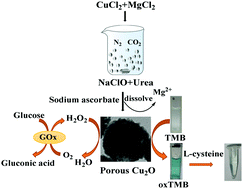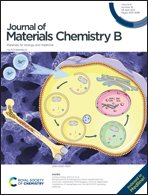A facile strategy for synthesis of porous Cu2O nanospheres and application as nanozymes in colorimetric biosensing†
Abstract
Due to the unique advantages, developing a rapid, simple and economical synthetic strategy for porous nanomaterials is of great interest. In this work, for the first time, using sodium hypochlorite as a green oxidant, urea was oxidized to CO2 as a carbon source to prepare the fine-particle crosslinked Cu-precursors, which could be further reduced by sodium ascorbate into pure Cu2O nanospheres (NPs) with a porous morphology at room temperature. Interestingly, our study reveals that introduction of an appropriate amount of MgCl2 into the raw materials can tune the pore sizes and surface area, but has no influence on the phase purity of the resulting Cu2O NPs. Significantly, all the synthesized Cu2O NPs exhibited intrinsic peroxidase-like activity with higher affinity towards both 3,3,5,5-tetramethylbenzidine (TMB) and H2O2 than horseradish peroxidase (HRP) due to the highly porous morphology and the electrostatic attraction towards TMB. The colorimetric detection of glucose based on the resulting porous Cu2O NPs presented a limit of detection (LOD) of 2.19 μM with a broad linear range from 1–1000 μM, much better than many recently reported composite-based nanozymes. Meanwhile, this nanozyme system was utilized to detect L-cysteine, exhibiting a LOD value as low as 0.81 μM within a linear range from 0 to 10 μM. More interesting, this sensing system shows high sensitivity and excellent selectivity in determining glucose and L-cysteine, which is suitable for detecting serum samples with reliable results. Therefore, the present study not only develops a simple strategy to prepare Cu2O NPs with controllable porous structure, but also indicates its promising applications in bioscience and disease diagnosis.



 Please wait while we load your content...
Please wait while we load your content...